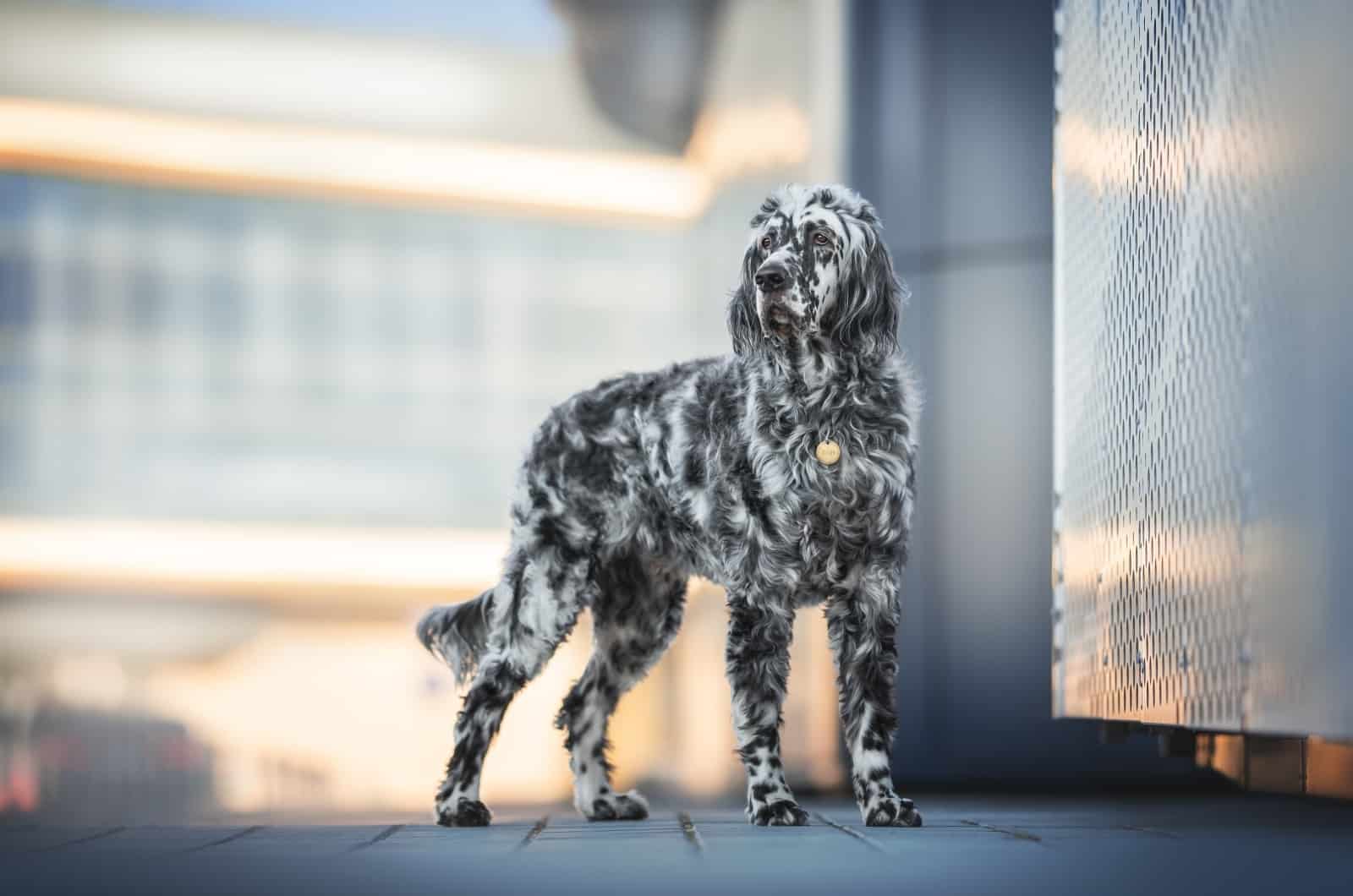While we find most of the well groomed and clean-looking dogs beautiful, there’s some beauty in a little bit of scruff like with the English Setter and the many English Setter colors that exist out there, but what are they?
Well, there are about 6 English Setter colors, one of which is particularly rare and not considered a standard color by the AKC (American Kennel Club), meaning English Setters of that color wouldn’t be allowed to compete in conformation shows.
But for those of you who aren’t really that big on dog shows in general, it’s an extra opportunity to find a color that you feel best fits for your dog and your own general preference.
That said, specific colors can rack up a price in a dog or leave him more prone to some health issues, especially non standard colors.
That’s something we need to take into account when looking into colors for a specific dog breed, which is what we’re here to find out today.
Do keep in mind that it’s not all about color either as this fantastic pooch makes for an excellent family dog too and is pretty active, making him one of the better, and less common choices out there.
If you want to find out more about the breed, its many different colors as well as any potential quirks or specifics about them that people often ask about, be sure to read on to get your answers.
English Setters: A Brief History
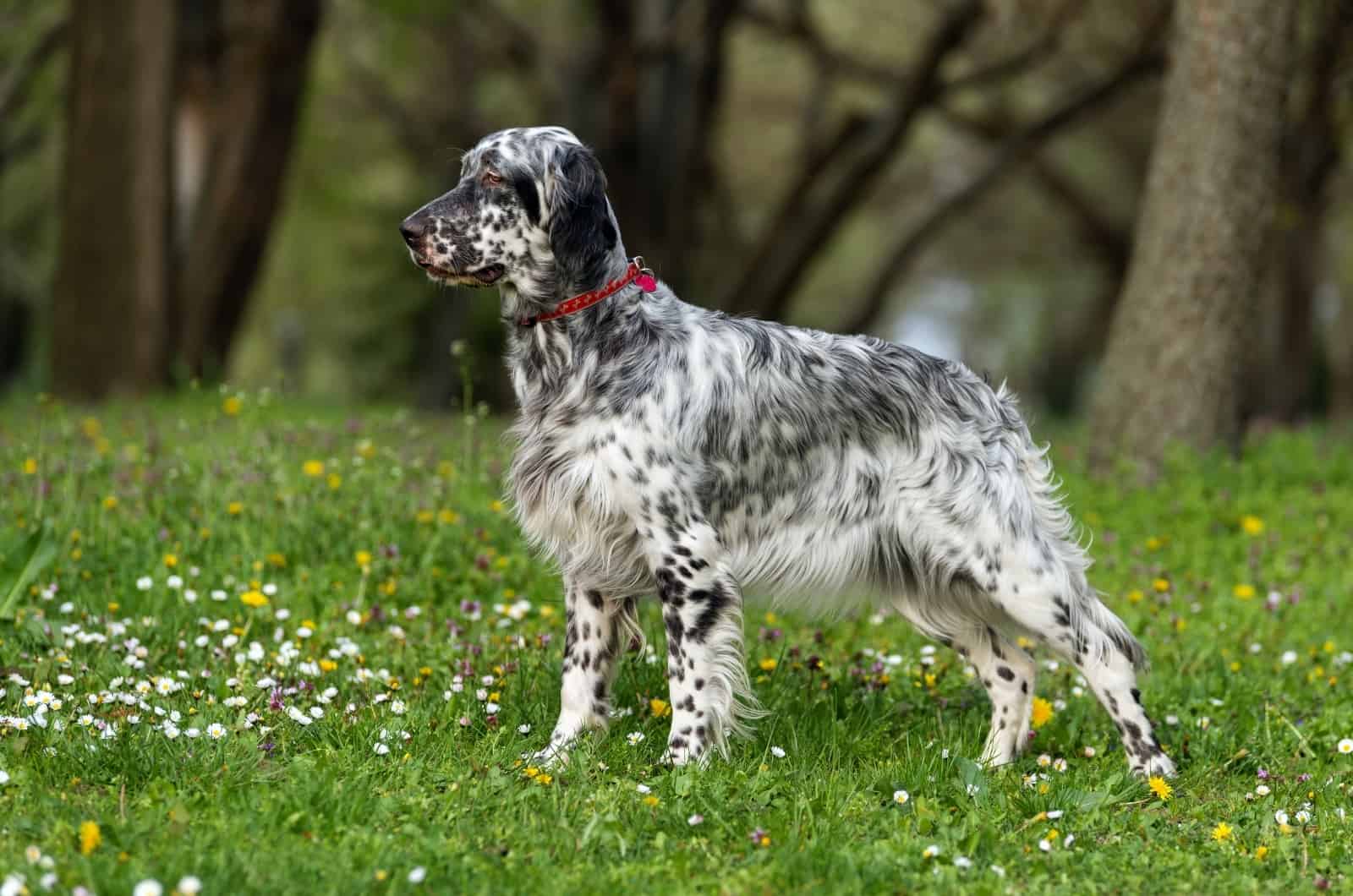
The name Setter comes from an older name for the English Setter breed “setting dogges”” since they were, by nature, hunting dogs used to “set” game birds.
The records of the bird dog date as far back as the late 1500s, around the year 1576 in the notes of Johannes Caius, talking about a presumed blue belton colored English Setter.
At the time, it was assumed that the dog was a cross between the English Springer Spaniel, a large Water Spaniel and the Spanish pointer dog.
Once the 17th century hit, the breed was still around, however it was being adapted by breeders to the terrain where they found themselves, depending on country or region.
The current iteration of the English Setter as we know came about from two men from England known as Edward Laverack and Richard Purcell Llewellin back in the 19th century.
Laverack started it by breeding the modern English setter through careful trait selection.
This process would later be continued by Llewellin to make the ideal bloodline, though their names at the time would be better known as the Laverack and Llewellin Setters respectively.
The dogs would easily pass their respective field trials and would be highly regarded by many who sought such immaculate hunting dogs.
The breed would arrive on our shores in the late 19th century, somewhere around the year 1878, and would be registered as an official breed by the AKC in that same year.
The Standard English Setter Colors
While the English Setter was coveted by sporting groups, particularly ones who enjoyed hunting, in modern times, they’re also liked for their color variety and general friendliness.
They’ve adapted to becoming family dogs quite well, branching out from sporting dogs alone.
As far as standard colors are concerned, there are about 5 different colors to choose from, and they are as follows:
Blue Belton English Setters

One of the most common colors for the English Setter dog, one that makes the Setter look like a raggedy Dalmatian, is the Blue Belton, or Roan color pattern.
The dominant color is white with a lot of this bluish black speckle spread all over the body in a variety of shades.
Ticking can be anywhere from minimal to heavy.
Lemon Belton English Setters

Next up we have the Lemon Belton variant, one that, once again, has white as the dominant color, but the brownish orange and light tan that can be found in shades on the dog’s fur makes it this lemon-y color.
It’s quite similar to an Orange Belton in terms of coloration, but the lemon one is distinct by the dog having a pinkish coloration on his nose and around his eyes.
And, similar to the Blue Belton, the ticking can go from very light to heavy, depending on how strong the gene is.
Orange Belton English Setters
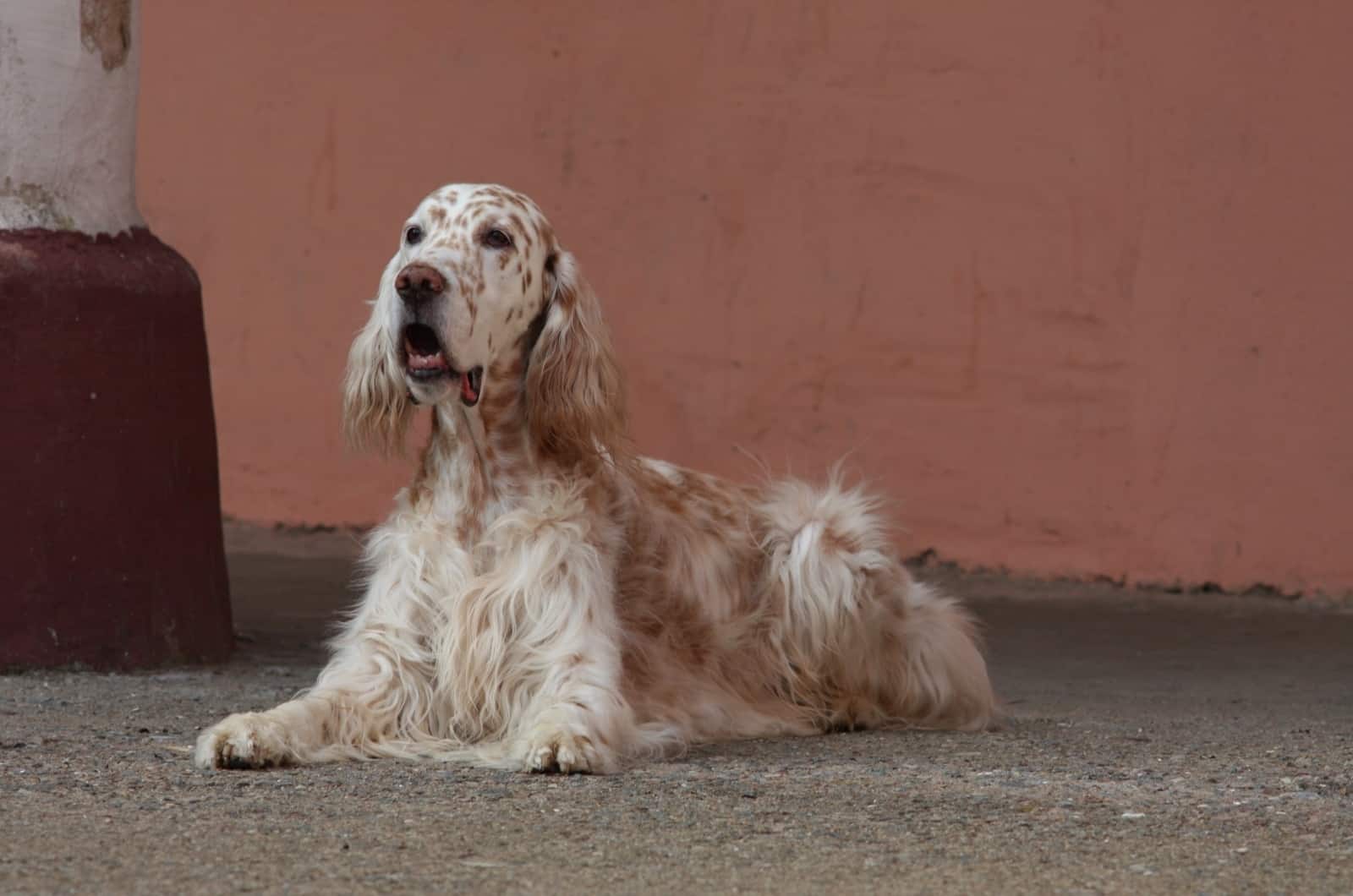
Speaking of the Orange Belton, that coat color option is up next.
Once again, it’s quite similar to the Lemon Belton variant with white being the dominant color with flecks of light brown or tan color strewn about that would appear orange when mixed together.
They don’t have the pinkish tinge to the eyes and the nose, but rather the more standard darker shades, and the orange color variant is more common than the lemon.
The coloration can vary in intensity, just like with any of the other previous options.
Blue Belton & Tan (Tri-Color) English Setters
Despite being a tri color option, it’s still considered a standard one, a mix of the Blue and Orange Beltons to a degree with specking from both colors that can intermingle with the dominant white.
The rest is standard as well with the nose and eye pigmentation sticking to the ordinary black instead of the pink that the lemon color gets.
And, even with three colors intermingling, the flecking on the coats can go anywhere from heavy to barely noticeable.
Chestnut Belton English Setters
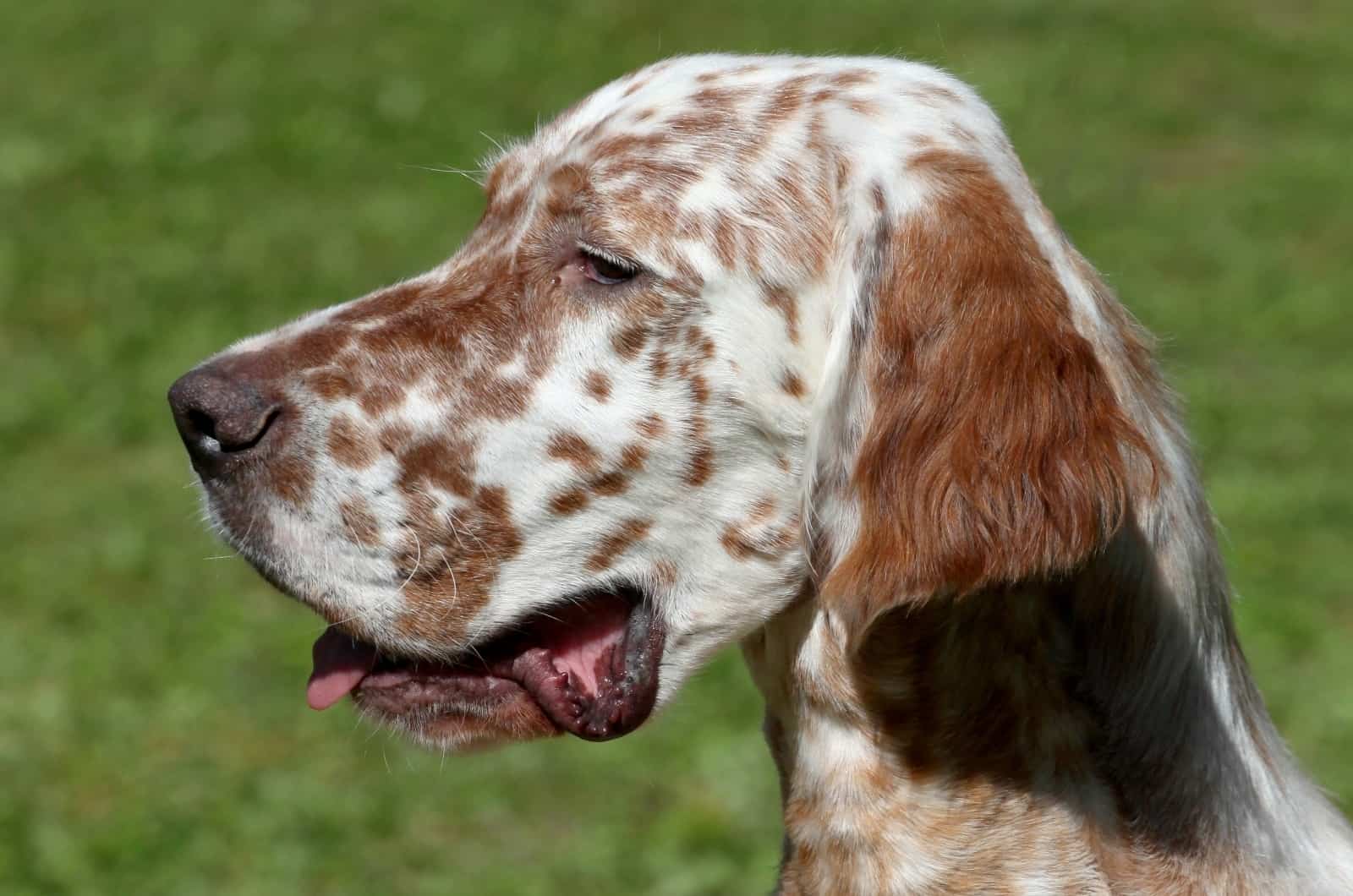
Also known as the Liver Belton English Setter, this particular color variant has a dark brown coloration, also known as liver or chestnut depending on specific pigment.
It’s definitely one of the more uncommon colors, often seen in the Ryman-type English Setter, but still considered to be the standard option.
The other unique aspect of these ones is that their nose and eye pigmentation is brown instead of the standard black or the pink of the Lemon Belton setter.
The coloration comes in flecks and can be lightly or heavily ticked, or anywhere in between.
These are the colors you should be sticking to if you’re looking to present your dog in the show ring and get them approved by the English Setter association of America
The Rare Non-Standard English Setter Color
Apart from those five, we also have the singular non-standard color which is quite rare and often considered a fault on an English Setter puppy, and that’s the pure white color.
White English Setters
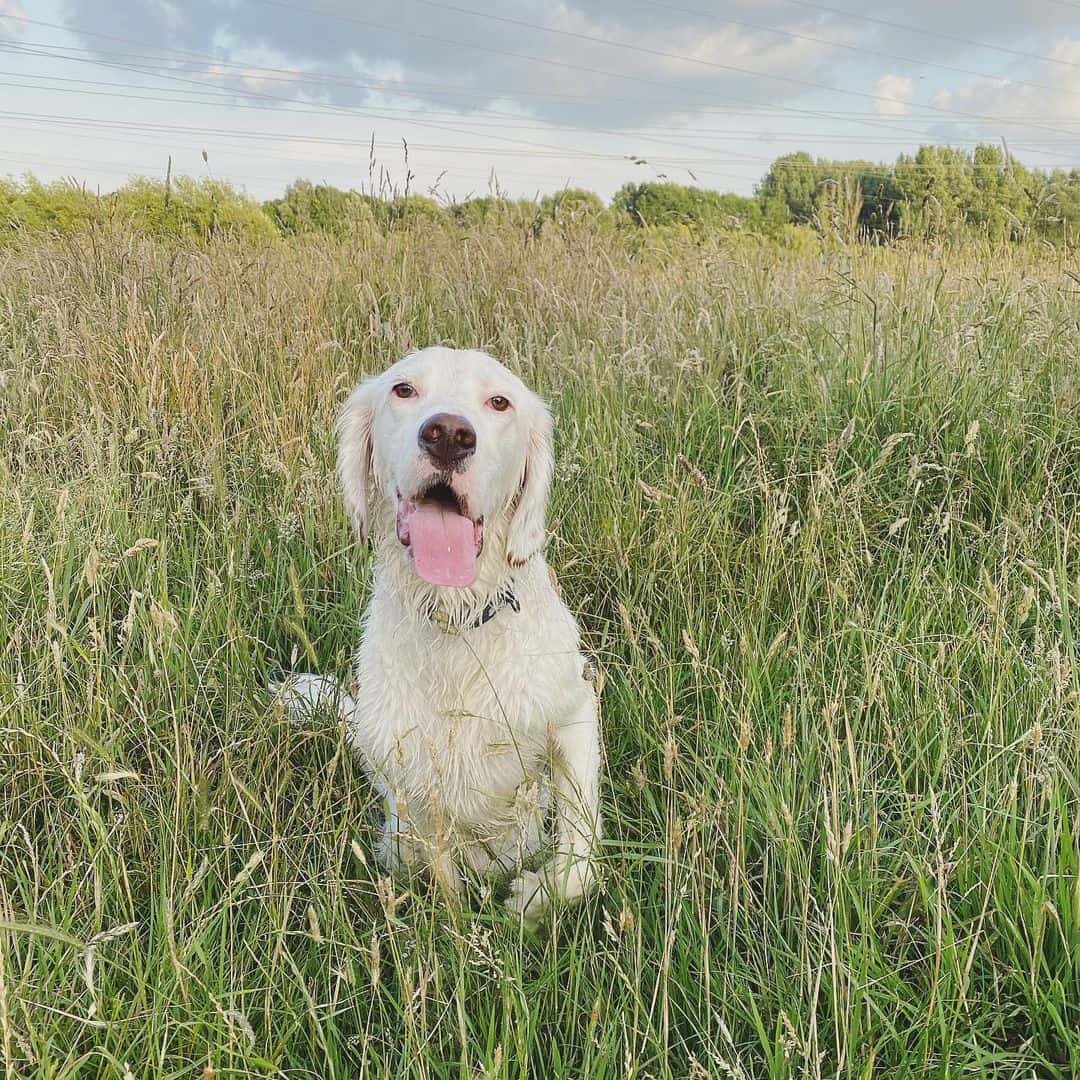
The White English Setter is one that simply has no other pigmentation and whose coat is entirely white.
This is considered a non-standard color and will not have the dog be eligible for entry into the show dog world.
FAQs
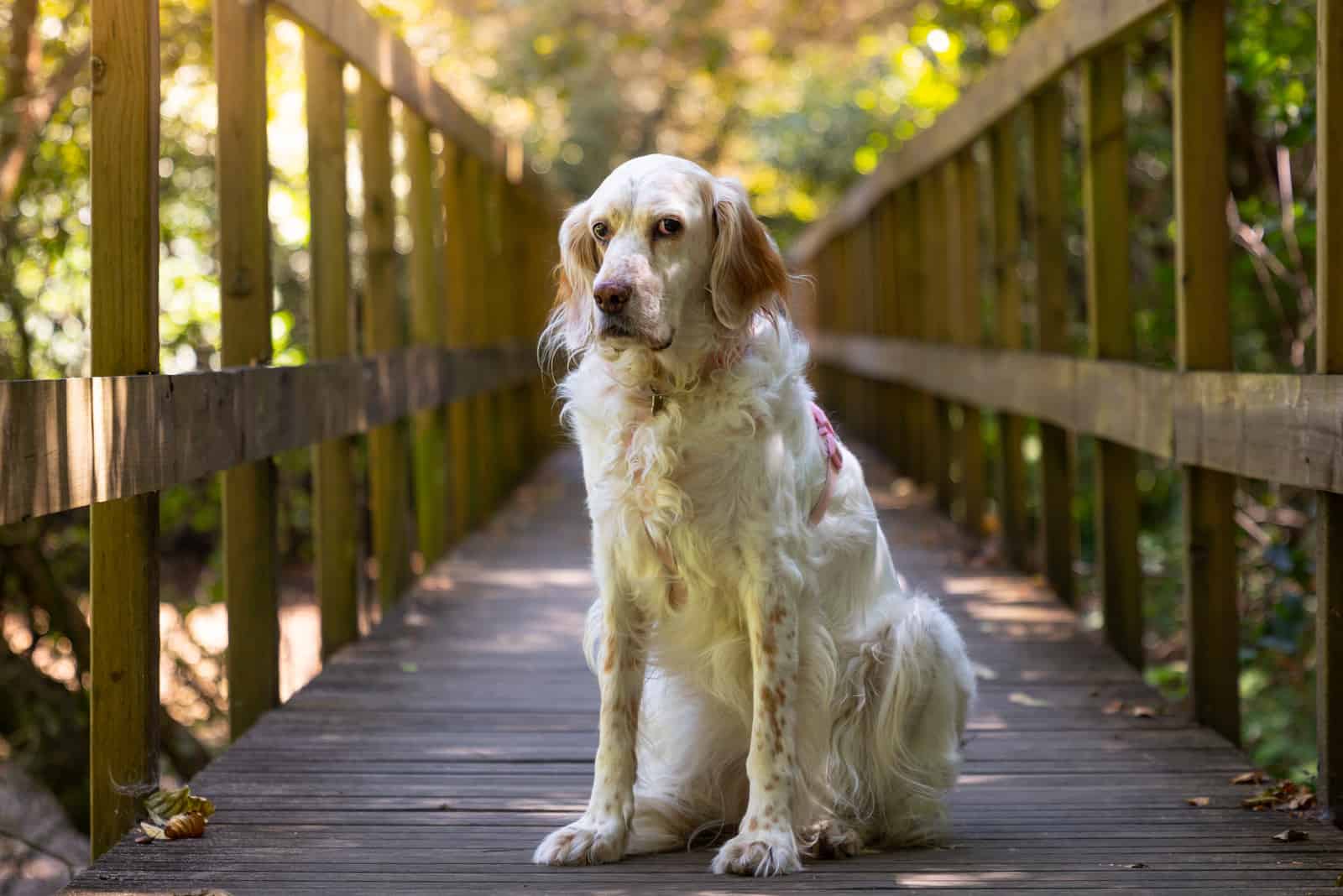
What do English Setters Normally Look Like?
Apart from all the color, English Setters do have a genuinely pleasant appearance, one often compared to elegance.
They’re part of the setter group alongside Irish Red and White Setters, Red Irish Setters, as well as the Black and TanGordon Setters.
Their medium length, silky coats resemble fancy gowns which give them that extra charm and allure while their well defined head fits their body perfectly and only serves to further accentuate said elegance.
It’s the type of dog you’d often see pictured next to an intellectual with their default expression seeming to be that of being deep in thought.
Going back to their fur briefly, they also possess a double coat, developed to help protect them from the elements, particularly rain and during hunts.
The outer coat often carries that white pigment while the undercoat is the one with all the other color options.
Given the density of the fur, they are moderate shedders and combing them at least once a week is recommended for grooming purposes.
There’s also a distinction between the field type and show type Setters with the former appearing a little less flamboyant with shorter fur while the show type Setter is the one described earlier with moderate length fur that’s more feathery.
As for their size, the males are larger, going at around 70-75 pounds on average with females only hitting 50-ish pounds, weight wise.
Height wise they’re relatively similar, anywhere between 23 to 27 inches.
What’s The Average Life Expectancy Of An English Setter?
The average lifespan for an English setter is commonly believed to be around 11 to 12 years of age.
That said, healthy dieting, good genes and healthy doses of exercise have been known to extend that estimate all the way up to 15 years, so English Setter owners are going to enjoy having their furry friend around for a good while.
What About Their Temperament?
English Setters are relatively calm when indoors, acting like couch potatoes who love to cuddle, but they can be pretty active outside.
They aren’t that big a problem in regards to other people, dogs or small children either, assuming you’ve had them go through early socialization.
Their energy levels are fairly high and they will need about 2 hours of moderate physical exertion to meet their daily quota.
It definitely is a lot more than that of other breeds, but it will help you stay active and in shape as well.
How Much Should I Be Feeding My English Setter Daily?
An adult English Setter consumes about 2 to 4 cups of high quality dry dog food a day on average which needs to meet his nutritional needs too.
Make sure the food covers fields like:
A good protein like chicken or beef
Some fiber like sweet potatoes or rice
Omega 3 fatty acids
Vitamins
Probiotics
As little artificial ingredients as possible
There are more options that need covering, but those are the essentials, the rest are optional in adulthood like calcium, phosphorus, glucosamine and chondroitin, but are very much welcome if you can find them.
And, naturally, avoid any food that contains a potential allergen for your dear doggo.
What Are Some Of The More Common Health Issues For The English Setter?
Despite having a relatively decent lifespan, there are a few health problems that can make matters worse for an English Setter.
Some are more common, some less so, but they’re all annoying to have to deal with.
They are as follows:
Elbow And Hip Dysplasia
A relatively standard problem for any breed, albeit it happens more in medium and large dog breeds like the English Setter and similar.
It’s a condition where the joint wears out and dislocates, and causes a lot of pain for the pooch.
Unfortunately, it’s not something that can be fully fixed, but medication can help dull the pain.
The best method of prevention is keeping your dog at a healthy weight, but that won’t help fully alleviate the chances of it happening.
Epilepsy
Due to some abnormality in the brain, your dog may end up experiencing epileptic seizures, and English Setters are more prone to contracting it than some other dog breeds.
There isn’t really a cure for the condition, but know that the dog will need to be monitored at all times as these seizures can be deadly.
It’s also worth mentioning that if a dog does indeed have epilepsy, their life expectancy tends to be shorter than that of other dogs.
Progressive Retinal Atrophy
Progressive Retinal Atrophy, or PRA for short, is a condition where the retinal rods and cones that help the dogs see in the first place start to slowly degrade, worsening vision over time until he goes completely blind.
It’s thankfully not an overly painful condition, but the consequences of it are life-changing in a negative way.
Though, the condition will only affect their sight, other than that they’ll be relatively healthy and can continue life as normal without this affecting their lifespan at all.
Deafness
Deafness is another problem that English Setters seem to be prone to, and if paired with PRA, can be a real cruel fate for a doggo.
The issue affects a surprising number of their kind (around 10%), and can happen at any stage of their life, including birth.
There sadly is no cure for this one as it’s purely genetic and the best thing you can do for them is to be there as their guide.
Bloat
A condition that isn’t exclusive to the English setter and can occur with any dog.
Bloat is something that affects the stomach and its surrounding organs and it’s what happens when your dog’s distended stomach tries to contract back into its original shape, only to twist around itself, closing off entry and exit into it.
This ends up trapping whatever liquid, gas or other stomach content there is inside and makes the surface of the stomach hard, all the while its position can cut off blood flow to surrounding organs, putting them at risk of failure.
This is a life-threatening condition and should be treated by a vet as soon as humanly possible because it is reversible, but needs to be taken care of before any permanent damage is done.
The best way to prevent it is to teach your dog to pace himself when eating and to not overeat, but even that may not fully eliminate the possibility of bloat occurring.
Hypothyroidism
Hypothyroidism is a condition where the thyroid gland isn’t producing enough of its hormones, causing the metabolism to slow down which has an adverse effect on the dog’s body.
It’s easily noticeable if you see your dog missing patches of fur, getting a sudden increase in weight and a seeming lack of energy or full on lethargy among other symptoms.
Should you notice any of those, I advise taking him to the vet to see if he gets diagnosed with hypothyroidism, in which case you’ll need to start putting him on treatment.
While the treatment is lifelong, it doesn’t impede any of the dog’s functions and he can safely continue living a normal life, just make sure to properly control the dosage.
Parasites
Finally, parasites are another universal health problem that’s pretty common among dogs considering the things they put in their mouth without us even knowing.
Parasites most commonly enter the body through uncooked meat or some infested bit found on the ground that the dog swallows, latching onto their digestive tracts and nestling there, siphoning nutrients off the food he eats to feed themselves.
This leaves the dog malnourished and lethargic and can have a big impact on his growth and overall health if it happens during his puppy period as it can lead to a lot of sudden weight loss.
The best way to avoid the issue is to test your dog’s stool for worms frequently and take him to deworming procedures.
Leaving the parasite unattended can become life-threatening, so get him the help he needs as quickly as possible.
In Conclusion
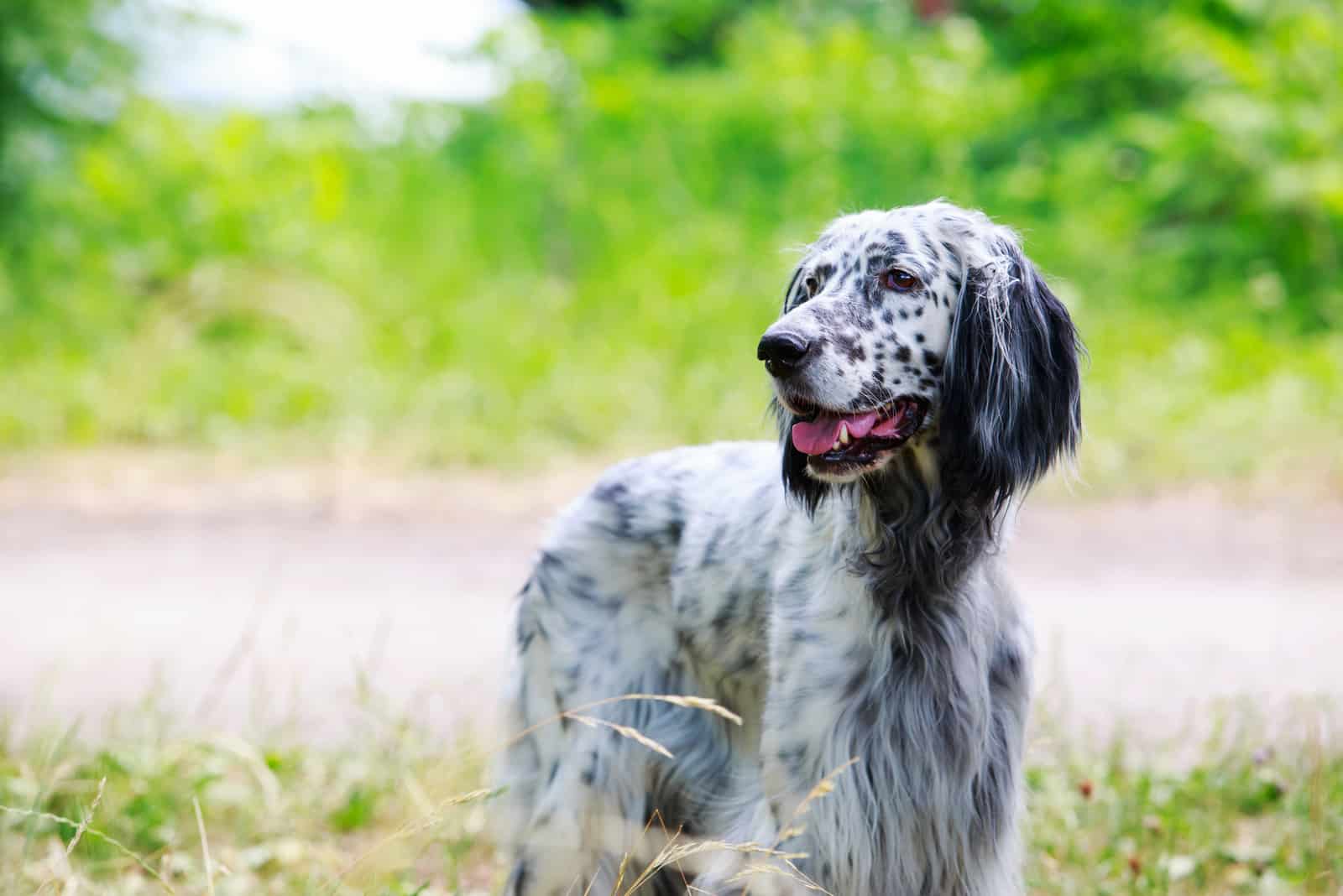
The variety of English Setter colors may not seem like much, but you’d be surprised how varied they can be from one member of the breed to another.
The aesthetic fits their whole vibe of being high energy when outside and extremely chill and low energy with the desire to cuddle while at home with their owner.
They’re one of the most likely dogs you’ll find in commercials where a happy family is resting at a cabin in a cozy hillside village or any similarly relaxing activity.
They don’t require a lot of maintenance outside of the physical exercise bit and will provide you with so much, as long as you can meet said need and provide them with love, which I’m more than certain that you can.
Until next time, pet parents.
RELATED LINKS:
